About Cottonwoods
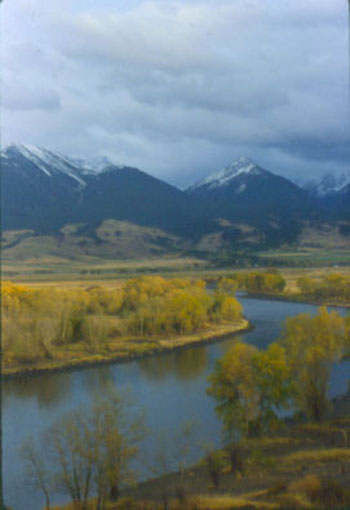
Cottonwood forests provide habitat for more than half the bird species in Montana, while hundreds of thousands of spring and fall migrating birds seek these riparian corridors for food and shelter. In the western US they support a higher diversity of breeding birds than all other western habitats combined.
Sixty percent of passerine species breeding in the west do so primarily in riparian areas. In addition, higher species diversity and density of amphibians and mammals are found in these riverside areas. Elk, mule deer, pronghorn and cattle are drawn to these areas for shelter, food and water. And in one survey of white-tailed deer done in eastern Montana eighty-three percent were located within riparian cover.
The Life of Cottonwoods
To understand cottonwoods, we must understand the dynamics of western rivers. When streams are unfettered by dams and other unnatural obstructions, each spring begins a process of rising and receding water that is paramount to the survival of cottonwoods. The high water of spring scours the riverbanks and moves material downstream where it is deposited as a layer of fine silty soil on sand and gravel bars. As the waters begin to recede, the cottonwoods release their small seeds (there are approximately 500,000 seeds to a pound) and these seeds are dispersed widely by the water and breezes and deposited on the sand and gravel bars which, thanks to the natural process of the spring flood, are adorned with that layer of fine, silty soil that is ideal for cottonwood germination.
Cottonwood seeds require bare soil, moisture and sunlight to germinate and begin to grow. However, they are short-lived (less than two weeks) and if conditions aren’t right, a full year must pass before the cottonwoods will release the seeds under positive growing conditions.
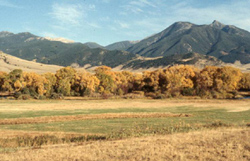 Even if the seeds do germinate, the survival rate is quite low and after eight weeks they have thinned considerably. Cottonwoods must be located low enough in the river channel to receive adequate moisture, yet high enough to be protected from scouring floods or ice floes. Their root systems must grow quite fast when they are young to keep up with the decline in water level as the stream recedes. Cottonwoods use water inefficiently, which is a disadvantage on sites prone to drought, but an advantage on infertile, continually moist sites. Cottonwoods are therefore closely adapted to the dynamics of meandering streams.
Even if the seeds do germinate, the survival rate is quite low and after eight weeks they have thinned considerably. Cottonwoods must be located low enough in the river channel to receive adequate moisture, yet high enough to be protected from scouring floods or ice floes. Their root systems must grow quite fast when they are young to keep up with the decline in water level as the stream recedes. Cottonwoods use water inefficiently, which is a disadvantage on sites prone to drought, but an advantage on infertile, continually moist sites. Cottonwoods are therefore closely adapted to the dynamics of meandering streams.
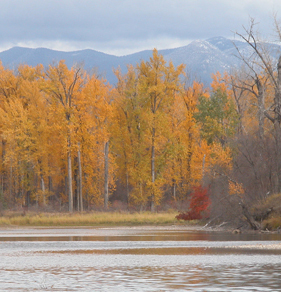 The Decline of Cottonwoods
The Decline of Cottonwoods
To continue to have healthy cottonwood communities, we need to have a 1:1 ratio of replacement trees (seedling, sapling and pole stages) to mature trees. What researchers are finding is that at best the replacement rate is 75%. At that rate, we will lose one-fourth of all cottonwood sites in Montana in the next 50 years. And that is assuming that all saplings somehow will survive to become mature trees. The reasons for the decline of cottonwood forests are many and varied.
Dams
Dams affect riparian zones in many ways. The velocity of water decreases as streams approach reservoirs, which means that sediment precipitates and drops to the floor of the reservoir instead of flowing down river. Reservoir levels are usually lower in spring in anticipation of spring runoffs. Therefore much of the water received from spring snow melt is contained behind the dams. The reductions of water flow caused by damming also impedes the ability of the river channel to change course, thereby reducing the meandering nature of a river. And dam management activities usually prohibit natural spring floods and a gradual reduction of flows through out the summer – just the cycle that cottonwoods need.
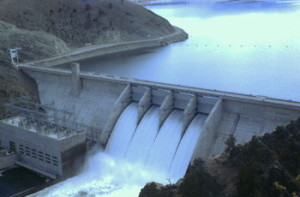 A study on the Missouri River determined that before the installation of dams it was a natural occurrence to have spring floods with flows in excess of 50,000 cubic feet per second (cfs) on an average of once every three years. The same study also concluded that cottonwoods on the Missouri need a runoff of at least 50,000 cfs once every nine years in order to continually reproduce successfully. In the high water spring of 1998, following one of the wettest winters on record, the highest recorded level was only 42,000 cfs.
A study on the Missouri River determined that before the installation of dams it was a natural occurrence to have spring floods with flows in excess of 50,000 cubic feet per second (cfs) on an average of once every three years. The same study also concluded that cottonwoods on the Missouri need a runoff of at least 50,000 cfs once every nine years in order to continually reproduce successfully. In the high water spring of 1998, following one of the wettest winters on record, the highest recorded level was only 42,000 cfs.
Development
 Because of our need for and attraction to water we continue to alter our landscape in ways that threaten the existence of these important cottonwood forests. More and more subdivisions are blotting the rural areas of Montana, directly impacting riparian habitat. In addition, many landowners are faced with “ripraping” and shoring up of river banks. These actions forever change the natural processes that will occur downstream–processes necessary for the survival of cottonwoods.
Because of our need for and attraction to water we continue to alter our landscape in ways that threaten the existence of these important cottonwood forests. More and more subdivisions are blotting the rural areas of Montana, directly impacting riparian habitat. In addition, many landowners are faced with “ripraping” and shoring up of river banks. These actions forever change the natural processes that will occur downstream–processes necessary for the survival of cottonwoods.
We need to educate landowners about the need to protect riparian areas. Quite often people build homes on our rivers without realizing that flood plain areas are a natural part of the river’s yearly cycle and that cottonwoods are uniquely adapted to these areas–and in fact cannot survive elsewhere.
Exotics
Exotic, non-native species can out-compete cottonwoods for survival. Two notable exotics that endanger cottonwoods are Salt Cedar and Russian-Olive.
Salt Cedar was first reported in Montana in the early 1960’s along the Bighorn and Yellowstone Rivers. It has now also been discovered on the Missouri River. This shrub is native to Mediterranean and Eurasian locales and produces an enormous number of seeds throughout the growing season. It has the ability to germinate and survive in highly saline soils and is therefore better able to tolerate the salts that often leach from agricultural fields.
Russian-Olive is a Eurasian tree that has been promoted as an excellent plant for windbreaks and erosion control. It was also thought that by planting Russian-Olive we could create more wildlife habitat. In fact, some extension forestry and state forestry departments have subsidized the distribution of Russian-Olive for this purpose. We now know that the introduction of this species of tree has had just the opposite effect.
Both of these species support a smaller diversity of insect species and therefore less diversity of bird and other wildlife. Studies suggest that there are 30% fewer bird species breeding in Russian-Olive communities as compared to cottonwood habitat. Once these imported plants become established, their habitat become a near monoculture with virtually no undergrowth. As with most exotic species, once these are established they are incredibly difficult to remove.
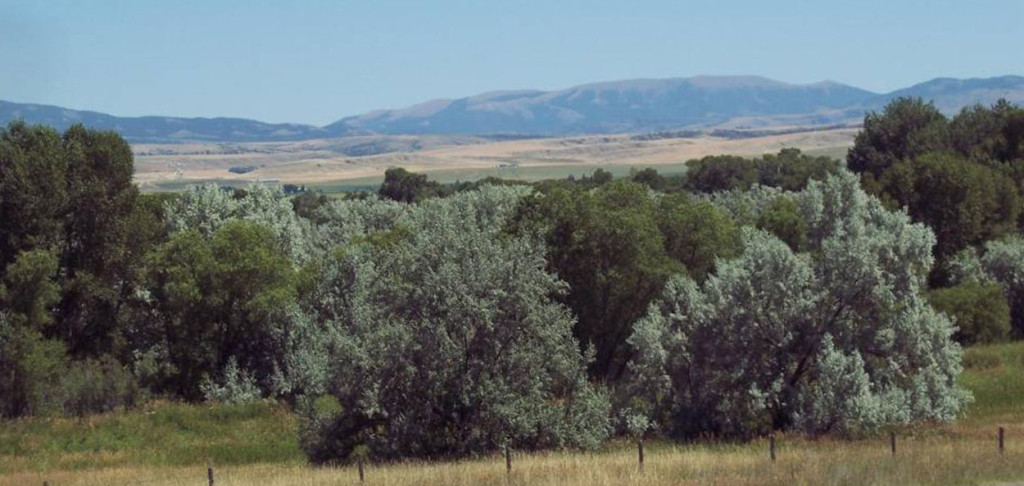
Grazing
Young cottonwood seedlings are very vulnerable to grazing of both wildlife and domestic animals. Moderate grazing can cause an increase in plants like snowberry and woods rose, while prolonged overgrazing can reduce the overall shrub cover and make the cottonwoods’ environment susceptible to a variety of exotic grasses. While grazing can help a few bird species, there are at least 24 species that respond negatively to grazing. These are species that nest or forage in shrubs and the effects of grazing can leave them vulnerable to predation.
Logging
At this time logging of cottonwood forests in Montana is probably more a potential than a real threat. However, if the market for cottonwood pulp or lumber improves, this could become a major detriment to Montana’s cottonwoods.
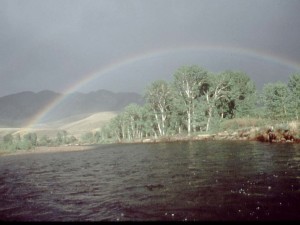 The Future of Cottonwoods
The Future of Cottonwoods
Cumulatively, all of these activities will continue to cause the disappearance of our native cottonwoods and threaten birds and other wildlife species dependent upon these riparian forests. Protecting cottonwoods means protecting the natural processes that create habitat for them.
The process of cottonwood degradation is slow and often exceeds the human lifespan. Therefore it is difficult to notice the gradual reduction of riparian forest. Through studies, interviews and historical photographs we know that many of these areas have been completely lost.
There is much to be done and we all need to get involved in order to preserve this important Montana resource.